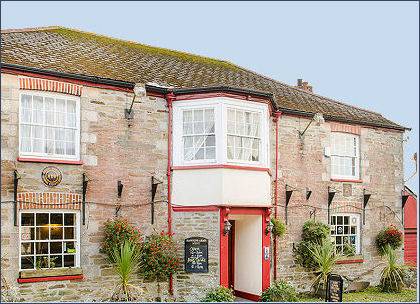Probus
OS grid reference - SW 8947
 The ancient village of Probus, known in Cornish as Lannbroboes is situated on the Roseland Peninsula, it lies just of the A390 and is close to St Austell. The village is famous for having the tallest church tower in Cornwall, which measures 129 feet (39 metres) high, and is richly decorated with carvings.
The ancient village of Probus, known in Cornish as Lannbroboes is situated on the Roseland Peninsula, it lies just of the A390 and is close to St Austell. The village is famous for having the tallest church tower in Cornwall, which measures 129 feet (39 metres) high, and is richly decorated with carvings.
The village is mentioned in the Domesday Book of 1086, 'The Canons of St Probus hold PROBUS. During his life, King Edward (the Confessor) held it. 1 h. and 1 v. of land. It never paid tax. Land for for 8 ploughs; 4½ ploughs there; 5 slaves, 3 villagers and 8 smallholders. Pasture, 20 acres, 20 cattle; 160 sheep. Value 40 shillings.'. A monastery stood at Probus prior to the Norman Conquest of 1066, founded by the Saxon King Athelstan, it continued to exist until the reign of Henry I. King Henry gave the church of Probus to Exeter Cathedral and the clergy of Probus thereafter were a dean and five canons.
The village church of St. Probus and St. Grace dates mainly to the fifteenth century, the highly decorated building owes its existence to what was once a thriving wool industry in the area. St. Probus was as martyr of the Diocletian persecution (circa 304 AD). In the reliquary there are two skulls said to be of the patron saints. These were discovered during the 1850 renovation of the church, when a male and a female skull were found interred in the sanctuary wall near the site of the altar, and are believed to be relics of the couple.
A monument to the Hawkins family (pictured left) , whose ancestral home this was, stands in the churchyard. The Hawkins family, of which the geologist John Hawkins (1761-1841) was a member, moved from Kent to Cornwall in 1554.
 The wide main street is lined with elegant Georgian houses. The Hawkins Arms (right) dates from the eighteenth century and is located on Fore Street. A St Austell Brewery Pub, the Hawkin's Arms offers good, reasonably priced food. The three hundred year old Lamplighter Restaurant in the village is a recipient of the prestigious Craft Guild of Chefs award.
The wide main street is lined with elegant Georgian houses. The Hawkins Arms (right) dates from the eighteenth century and is located on Fore Street. A St Austell Brewery Pub, the Hawkin's Arms offers good, reasonably priced food. The three hundred year old Lamplighter Restaurant in the village is a recipient of the prestigious Craft Guild of Chefs award.
Probus Gardens, which lies to the east of the village, were planted in the 1970's and has sections devoted to organic vegetable growing as well as flowers and shrubs. The garden covers eight acres and is divided into different areas separated by hedges resistant to the salt-laden winds. 35 different hedging varieties were used at Probus. The sub divisions included an organic fruit and vegetable garden, a butterfly garden, a low allergen garden, a winter garden, a seaside garden tended by local schoolchildren and the Millennium herbaceous garden based on a Celtic design.
The farmhouse at Golden contains the remains of a hall-house of the late 1530s, reconstructed about a century later, and extended in the eighteenth century. There is also a fine barn with original roof timbers and a first floor window.
Trehane Barton is the former home of the Stackhouse family and a Site of Special Scientific Interest. The barns supported the largest known breeding colony of Greater Horseshoe Bat in Cornwall and one of only eleven known colonies in Britain.